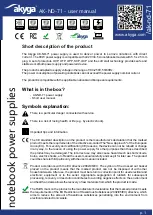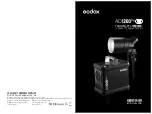
- 10 - FireSwitch108
Step 2. Program Protocol for Channels 1-8:
a . Select from: Steady, Code 3, Follower Mode, Potter, Carbon Monoxide (CO) Strobes,
Carbon Monoxide (CO) Horns, Gentex
®
, System Sensor
®
or CooperWheelock
®
.
Protocol Selection:
LCD
Legend
Function
Triggered From
Description
1a
Steady
Input 1
A steady output signal will be generated . This mode will ac-
cept steady or pulsing input .
2a
Input 2
3a
Redundant - Input 1 and Input 2 .
1b
Code 3
Input 1
Enables Temporal Code 3 signal generation output .
This mode will accept a steady or a pulsing input .
2b
Input 2
3b
Redundant - Input 1 and Input 2 .
1c
Follower Mode
Input 1
Output follows signal it receives from the corresponding
input (i .e . FACP Sync module - maximum synchronization
of notification appliance circuit) .
2c
Input 2
3c
First Input to go in alarm mode .
1d
Amseco/Potter
Input 1 (both horns and strobes) . This mode is designed to work with the Amseco/Potter
series of horns, strobes, and horn/strobes to provide a means
of synchronizing the Temporal-coded horns, synchronizing
the one-second flash timing of the strobe, and simultane-
ously deactivating both audible and visible notification
appliances .
2d
Input 2 (both horns and strobes) .
3d
Input 1 - strobes only .
Input 2 - horns and strobes .
1e
Carbon Monoxide
(CO)
Input 1 and Input 2 - strobes only .
This mode is designed to generate strobe sync signal during
both fire alarm and CO alarm . ONLY Combination CO and
Fire Alarm “NAC Output” Connections are allowed to be
made to meet UL864 10th Ed Requirements .
See Combination CO and Fire Alarm Connections on Pg. 15 .
2e
Input 1 and Input 2 - horns only .
This mode is designed to generate Code 3 horn temporal
code during fire alarm and Temporal 4 for system CO
alarms during CO alarm . ONLY Combination CO and Fire
Alarm “NAC Output” Connections are allowed to be made
to meet UL864 10th Ed Requirements .
See Combination CO and Fire Alarm Connections on Pg. 15 .
3e
Reserved
Reserved
1f
Gentex
®
Gentex is a registered
trademark of Gentex
Corporation .
Input 1 (both horns and strobes) . This mode is designed to work with the Gentex
®
series of
horns, strobes, and horn/strobes to provide a means of syn-
chronizing the Temporal-coded horns, synchronizing the
flash timing of the strobe, and simultaneously deactivating
both audible and visible notification appliances .
2f
Input 2 (both horns and strobes) .
3f
Input 1 - strobes only .
Input 2 - horns and strobes .
1g
System Sensor
®
System Sensor is a
registered trademark
of Honeywell .
Input 1 (both horns and strobes) .
This mode is designed to work with the System Sensor
®
series of horns, strobes, and horn/strobes to provide a means
of synchronizing the Temporal-coded horns, synchronizing
the flash timing of the strobe, and simultaneously deactivat-
ing both audible and visible notification appliances .
2g
Input 2 (both horns and strobes) .
3g
Input 1 - strobes only .
Input 2 - horns and strobes .
1h
CooperWheelock®
CooperWheelock is a
registered trademark
of CooperWheelock .
Input 1 (both horns and strobes) . This mode is designed to work with the CooperWheelock
series of horns, strobes, and horn/strobes to provide a means
of synchronizing the Temporal-coded horns, synchronizing
the one-second flash timing of the strobe, and
simultaneously deactivating both audible and
visible notification appliances .
2h
Input 2 (both horns and strobes) .
3h
Input 1 - strobes only,
Input 2 - horns and strobes .
b . Depress the joystick one (1) time from Function screen or two (2) times from Stand-by screen .
c . Use [Up/Down] to select Protocol, Use [Left/Right] to select outputs .
d . Use [Right] to copy setting to next output .
Note: Class A outputs are paired . If output is set for Ax or Bx - Protocol settings are not available .
Note: The Common Trouble Output Relay is to be connected to the FACP trouble input and the FACP
shall be Programmed to indicate both “CO and Fire Trouble” at the FACP Display .
For CO Alarms, the system must be monitored by a supervising station with emergency response.










































